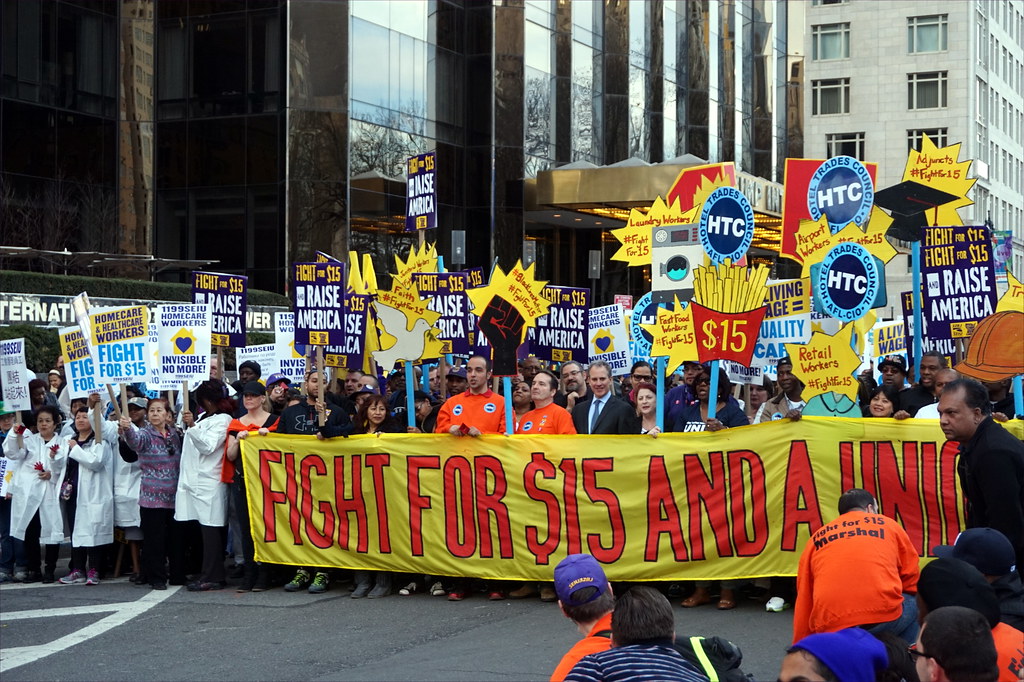
Image courtesy of Flickr.
This November, the majority of Floridians approved Amendment 2 with 60.8 percent of the vote. The amendment will raise Florida’s minimum wage—currently $8.56—to $10.00 per hour effective Sept. 30, 2021, after which the minimum wage will increase annually by $1.00 per hour until it reaches $15.00 per hour in 2026, when wages will revert to being adjusted annually for inflation. Workers earning minimum wage across Florida have rejoiced, but the implications for New College’s budget remain unclear.
According to Vice President of Finance and Administration Chris Kinsley, New College had been considering increases to the college’s minimum wage prior to Amendment 2’s passage, which will make raises obligatory via constitutional law.
In November, the college raised its institutional minimum wage from $8.56 to $9.00 for all workers, which costs about $22,000 more annually.
Kinsley said the college strongly considered raising the minimum wage to $10 prior to the passage of Amendment 2, but that it would have been too expensive. Raising the college’s minimum wage from $8.56 to $10 would have cost approximately $100,000 more per year. Kinsley said the sharp difference in figures is because the majority of workers at New College already made between $8.56 and $9.00, so the increase in costs were less significant.
| Minimum Wage Increase | Annual Added Cost |
| $8.56 > $9 | $22,000 |
| $8.56 > $10 | $100,000 |
“The college was originally thinking we would have to wait and see what the outcome of the legislative session was, and where we stood on the budget front to make the decision about [increasing the minimum wage] to $10 for the start of the 2021 fall semester,” Kinsley explained. “I think that’s still true, but now the question will be, ‘At $10 an hour, can we afford to provide the same number of hours to students or not?’”
At the moment, Kinsley’s hypothetical question remains unanswered. Amendment 2 must still pass through the Florida State Legislature, where it is likely to undergo significant changes under the Legislature’s GOP majority before becoming constitutional law.
The amendment also bears heavy implications for student workers and wage-earning staff alike. Between Aug. 23 and Oct. 31, 2020, the college spent $43,763.70 on student workers. Kinsley described some of the likely benefits and drawbacks of the amendment, focusing on the potential for reduced hours, academic progress and increased performance expectations.
“As the salary increases, the job expectations increase, so students might get more and better experience as they are asked to take on more,” Kinsley reflected. “The opposite is, as the salary increases, the college might have to look at qualified non-student workers—so if the job expectations increase, it might price students out of the market. But who knows? The interesting thing with a minimum wage like this is that the whole market is changing, so all workers in this class are going to be getting more dollars so the college may be competing for the same set of workers. A lot of it is just unknown.”
Professor of Sociology and Latin America and Caribbean Studies Sarah Hernandez also reflected on the amendment’s potential impact on New College staff making minimum wage. According to Kinsley, as of Nov. 13, the college employed 84 regular hourly employees, with 16 being paid $15.00 or below, and 29 Operations (OPS) hourly employees with 12 at $15.00 or below.
“As the minimum wage increases each year, worker’s earnings will slowly increase to at least match the yearly increases of the minimum wage,” Hernandez explained. “Depending on the extent to which NCF’s financial situation allows it and the labor union’s bargaining process, these employees may see an increase that is larger than the new minimum wage. As these workers increase their earnings, they also increase their purchasing power. This will allow them to improve their and their family’s quality of life not only currently, but also in the future. Workers receive employer contributions to their retirement fund that are a percentage of employee’s income. Therefore, they will also see an increase in their retirement savings.”
However, Hernandez also noted that, according to the Living Wage Calculator created by Dr. Amy K. Glasmeier, the 2020 living wage in Florida for a single adult should be $12.39. For a single earner with one or two dependent family members (say, spouse and child), it ranges between $24 and $25 dollars. If both spouses work to support the one child, the living wage should be $13.99 (in 2020). Therefore, the $10 minimum for 2021 is below the living wage for a family of three, even with two working adults. By 2026, the new minimum wage of $15—controlling for inflation—is also not likely to match the living wage of 2026, but such an increase will significantly reduce the likelihood of living at or below the poverty rate.
Although the eventual $15 minimum wage will likely fall short of the living wage required for 2026, in the short term, the new minimum wage of $10 for 2021 may carry benefits for students in that it will likely reduce the need for extra work hours, giving students more time to study.
Kinsley mentioned that he would like to see New College consider a limitation on hours. The current amount students can work is capped at 29 hours a week—beyond that, students would qualify for benefits.
“I think 29 hours is a lot for a rigorous academic program like New College’s, but really, at almost any school, to work almost a full time job and go to school full time is really hard,” Kinsley said. “Could we structure the job or expand training so that the person could do the same amount of work in fewer hours and still get the same amount of pay? This constitutional amendment is probably going to force that conversation.”
